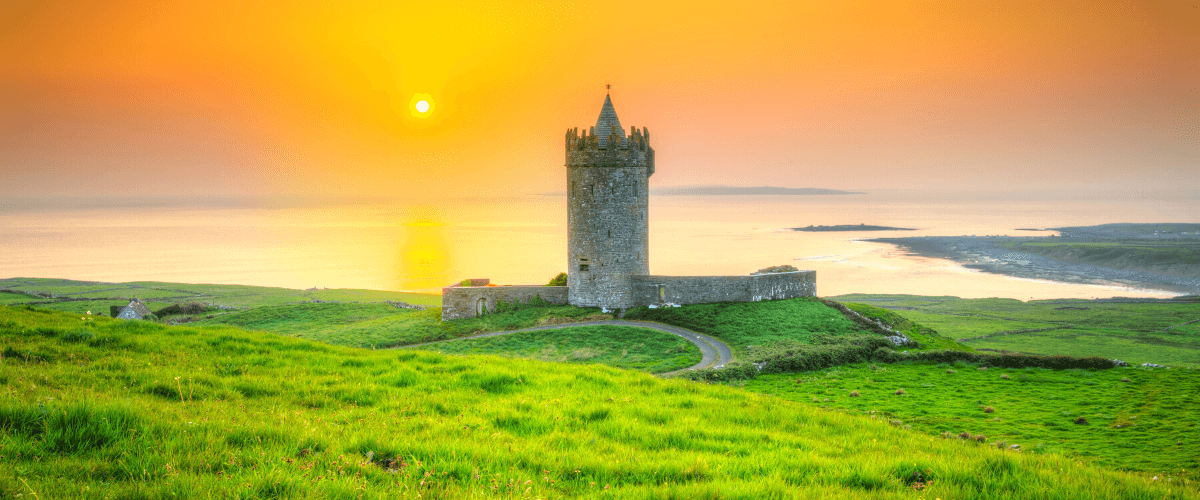Introduction to Irish Castles
Ireland is home to a fascinating Irish Castle History, showcasing a rich past and an abundance of fortresses that were crucial to the nation’s development. These castles not only served as fortified residences for the nobility but also as symbols of power and wealth. In this article, we will delve into the origins of Irish castles, their importance in Irish history and culture, and the role they played in medieval Ireland.
Brief overview of Irish castles
There are hundreds of castles dotting the Irish landscape, with some dating back to the 12th century. They come in various forms, including tower houses, strongholds, and fortified manor houses. Some of the most famous Irish castles include Blarney Castle, Kilkenny Castle, and the Rock of Cashel.
Importance of Castles in Irish History and Culture
Throughout history, Irish castles have played crucial roles in the lives of the Irish people. They served as centers of power and wealth, providing a safe haven for the nobility in times of strife. Additionally, they were often the sites of important historical events, such as battles and sieges, and have become iconic symbols of Ireland’s rich heritage.
Role of Castles in Medieval Ireland
In medieval Ireland, castles were essential for maintaining control and authority over the land. They provided protection and a strategic advantage in times of conflict. The feudal lords who ruled these castles would often levy taxes on the surrounding lands, further enhancing their power and wealth.
Understanding the Origins of Irish Castles
To understand the origins of Irish castles, we must first look at the historical context of their construction. The Norman invasion of Ireland in the late 12th century brought about significant changes in Irish society, including the introduction of feudalism and the construction of the first stone castles. These early castles were mainly built by the Anglo-Norman settlers as a means of solidifying their control over the newly conquered lands.
As time went on, the native Irish lords also began constructing their own castles, adopting the new architectural styles and defensive techniques introduced by the Normans. By the 15th century, the tower house had become the most common type of castle in Ireland, characterized by its tall, narrow design and stout defensive features.
Exploring the key historical events that influenced the construction and development of castles in Ireland
- Norman invasion (1169-1171): The arrival of the Normans in Ireland led to the construction of the first stone castles in the country. These early castles, such as Trim Castle and Carrickfergus Castle, were designed to withstand sieges and provide a base for the Anglo-Norman settlers to consolidate their power.
- Gaelic resurgence (14th-15th centuries): During this period, the native Irish lords began to reclaim lost territories and construct their own castles. This led to a blending of architectural styles, with many Irish castles featuring both Norman and Gaelic elements.
- Tudor conquest (16th century): The English Tudor dynasty sought to bring Ireland under its control, leading to the construction of numerous castles and fortified houses. These castles, such as Athlone Castle, were designed to provide a strong military presence and suppress any resistance from the native Irish population.
- Cromwellian invasion (1649-1653): The English Parliamentarian forces under Oliver Cromwell invaded Ireland, resulting in the destruction of many castles and the confiscation of lands from the Irish nobility. Some castles, like Birr Castle, were later rebuilt and repurposed by the new
- English landowners during the Restoration period.
- Williamite War (1689-1691): This conflict between the Catholic King James II of England and the Protestant King William III of England and Scotland resulted in further destruction of Irish castles. Castles such as Limerick and Athlone were besieged and damaged during the course of the war.
- 18th and 19th centuries: During this period, many castles were abandoned, fell into disrepair, or were transformed into stately homes or country estates. Some castles, such as Ashford Castle and Dromoland Castle, were converted into luxury hotels, providing visitors with an opportunity to experience a taste of Ireland’s historical past.
Origins and Early History
Pre-Norman Period
The earliest fortifications in Ireland date back to the Iron Age and can be categorized into three primary types: ringforts (ráths), promontory forts, and crannogs.
- Ringforts (ráths): These circular, fortified settlements were typically enclosed by one or more earthen banks and ditches. They were the most common type of early Irish fortification and served as the residences of local chieftains and their families.
- Promontory forts: Built on cliffs or headlands overlooking the sea, these forts offered both strategic and defensive advantages. Examples include Dun Aengus on the Aran Islands and the Grianan of Aileach in County Donegal.
- Crannogs: These artificial islands, constructed on lakes or marshy areas, provided additional security and protection from raiders. They were usually accessed by a hidden causeway or boat, making them difficult to attack.
During the 9th and 10th centuries, Viking settlers established longphorts, which were fortified encampments, often located near rivers or coastlines. These settlements, such as Dublin and Waterford, later evolved into important urban centers.
Arrival of the Normans
The Norman invasion of Ireland began in 1169 when a group of Norman, Welsh, and Flemish knights, led by Richard de Clare, 2nd Earl of Pembroke, commonly known as Strongbow, arrived in Ireland at the request of the exiled Irish king, Diarmait Mac Murchada. The Normans brought with them new forms of military architecture, most notably the motte-and-bailey castle.
- Motte-and-bailey castles: These early Norman castles consisted of a wooden keep (tower) built on top of a raised earth mound (motte), surrounded by an enclosed courtyard (bailey). The bailey was often protected by a wooden palisade and a ditch. These castles were relatively quick and easy to construct, making them ideal for the rapid Norman expansion in Ireland.
The key features of early Norman castles included:
- Wooden structures: Initially, most Irish castles were built primarily of timber. Over time, many of these wooden structures were replaced with more durable stone.
- Defensive earthworks: Mottes and baileys were often surrounded by defensive ditches and earthen ramparts to provide additional protection.
- Adaptations to the Irish landscape: As the Normans expanded their control over Ireland, they adapted their castle-building techniques to suit the local topography and materials, incorporating existing fortifications such as ringforts and crannogs into their designs.
By introducing motte-and-bailey castles and other innovative architectural techniques, the Normans played a pivotal role in shaping the development of Irish castles. Over the centuries that followed, these early fortifications would evolve into magnificent stone castles that still captivate visitors and serve as iconic symbols of Ireland’s rich history and culture.
Key Castle Developments in Ireland
Stone Castles in the 13th Century
During the 13th century, Irish castles underwent a significant transition from primarily wooden structures to more durable stone constructions. This shift was driven by a desire for increased durability, prestige, and enhanced defensive capabilities.
One notable innovation during this period was the introduction of the keep (or donjon), a large central tower that served both as a stronghold in times of attack and as the primary living quarters for the castle’s inhabitants.
Examples of these early stone castles include:
- Trim Castle, County Meath: Built in the late 12th century, Trim Castle is the largest Norman castle in Ireland, featuring a massive central keep surrounded by a curtain wall and a moat.
- Carrickfergus Castle, County Antrim: Constructed in the late 12th century, this coastal fortress is one of the best-preserved medieval structures in Ireland and features an imposing keep, a curtain wall, and a gatehouse.
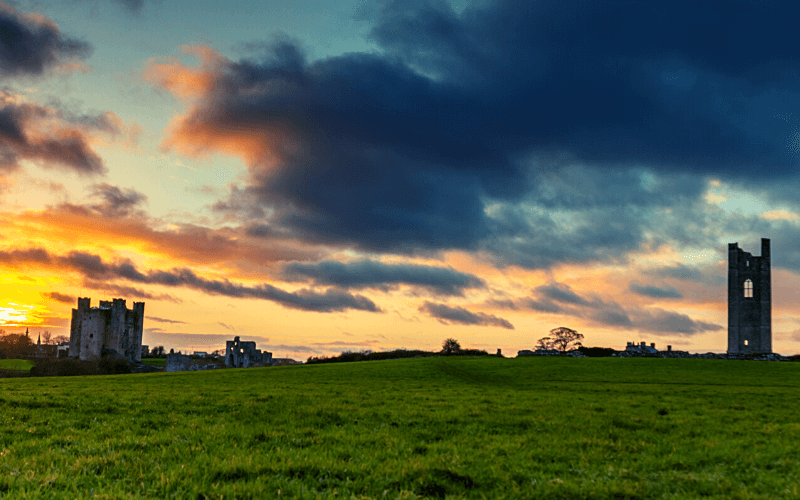
Tower Houses in the 15th-16th Centuries
The 15th and 16th centuries saw the emergence and popularity of tower houses in Ireland. These smaller, more affordable castles were both defensive structures and status symbols for the local gentry and wealthy landowners.
Key features of tower houses include:
- Rectangular, multi-storied structures: Tower houses were typically built with a rectangular plan and consisted of multiple floors, each serving a different function, such as living quarters, storage, or defense.
- Spiral staircases: These narrow, winding staircases were a common feature in tower houses, providing access between floors and serving as a defensive measure by making it difficult for attackers to ascend.
- Machicolations and parapets: To enhance their defensive capabilities, tower houses often featured machicolations (openings in the floor for dropping stones or other projectiles) and parapets (low walls along the roofline) for archers.
Notable examples of tower houses in Ireland include:
- Blarney Castle, County Cork: Famous for its legendary Blarney Stone, this 15th-century tower house boasts impressive battlements, machicolations, and a spacious courtyard.
- Ballynahinch Castle, County Galway: Built in the 16th century, this tower house is situated on a picturesque lake and features a striking exterior with stepped gables and bartizans (corner turrets).
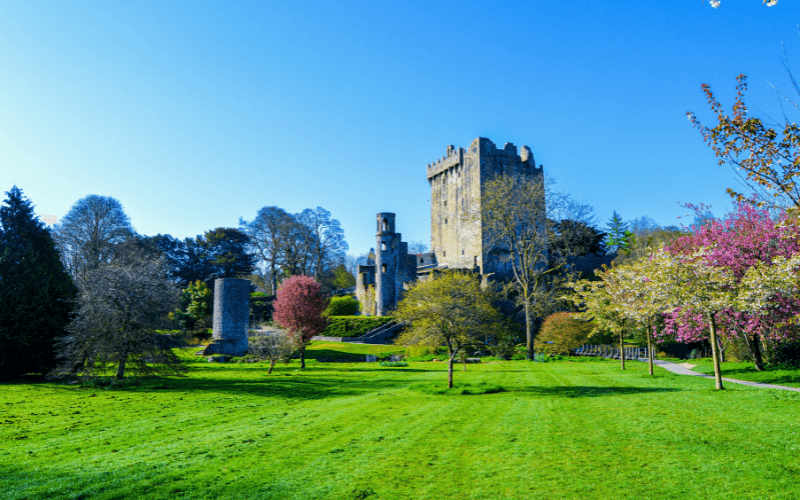
Fortified Manor Houses in the 16th-17th Centuries
As the 16th and 17th centuries unfolded, traditional castles in Ireland began to decline in popularity, giving way to fortified manor houses. This shift was driven by political changes, advancements in weaponry (such as the introduction of gunpowder), and an increased focus on comfort and domestic living.
Key features of fortified manor houses include:
- Domestic living spaces: Unlike earlier castles, which prioritized defense, fortified manor houses placed a greater emphasis on comfortable living quarters, often featuring large windows and spacious interiors.
- Defensible features: Despite the focus on comfort, these manor houses still incorporated defensive elements, such as gun loops (narrow openings for firing guns) and fortified walls.
Examples of fortified manor houses in Ireland include:
- Rathfarnham Castle, County Dublin: Constructed in the late 16th century, this manor house features Renaissance-style architecture, with ornate plasterwork, large mullioned windows, and a fortified bawn (enclosed courtyard).
- Kanturk Castle, County Cork: Built in the early 17th century, Kanturk Castle blends domestic comfort with defensive features, such as gun loops and corner towers, while also showcasing a spacious interior with large fireplaces and decorative stonework.
Notable Irish Castles
Dublin Castle
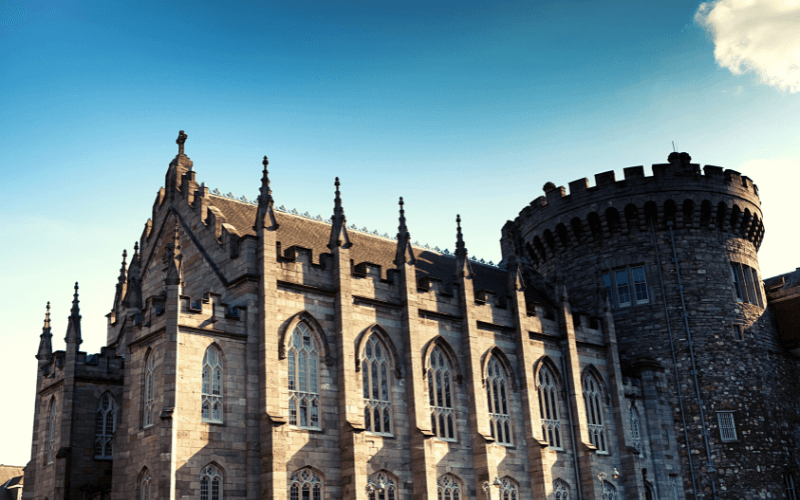
Dublin Castle has played a pivotal role in the history of Ireland. As the seat of English and British rule for centuries, it was the epicenter of political power and administration in the country. Today, it remains an iconic symbol of Ireland’s past and present.
Key features of Dublin Castle include:
- Record Tower: The oldest surviving structure within the castle complex, the Record Tower was built in the early 13th century and originally served as a defensive stronghold.
- State Apartments: These opulent rooms, showcasing a mix of architectural styles, were once the residence of the Lord Lieutenant of Ireland and now host important state functions and events.
Link to Dublin Castle website.
Bunratty Castle
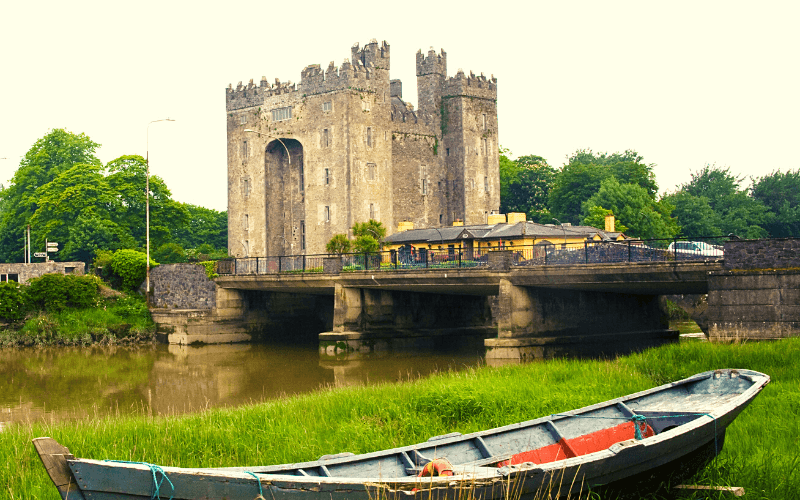
Bunratty Castle’s history dates back to the Viking era, when it served as a trading camp. Over the centuries, several iterations of castles were built on the site, with the current structure dating back to the 15th century.
Today, Bunratty Castle is a popular tourist destination, thanks to its meticulous restoration to its 15th-century appearance. Visitors can explore the castle and its surrounding folk park, which provides a glimpse into Irish rural life in the past.
Link to Bunratty Castle website.
Kilkenny Castle
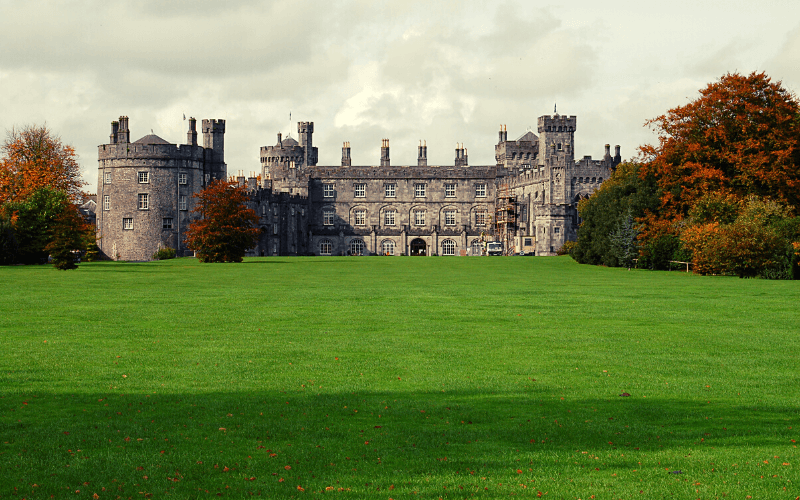
Kilkenny Castle was once the seat of the powerful Butler family, who held significant influence in the region. The castle’s history spans over 800 years and reflects the various architectural styles of the time, including Norman, Gothic, and Victorian elements.
The expansive parkland surrounding Kilkenny Castle provides a serene setting for visitors to enjoy, while the castle itself offers guided tours that highlight its rich history and architectural beauty.
Link to Kilkenny Castle website.
Rock of Cashel
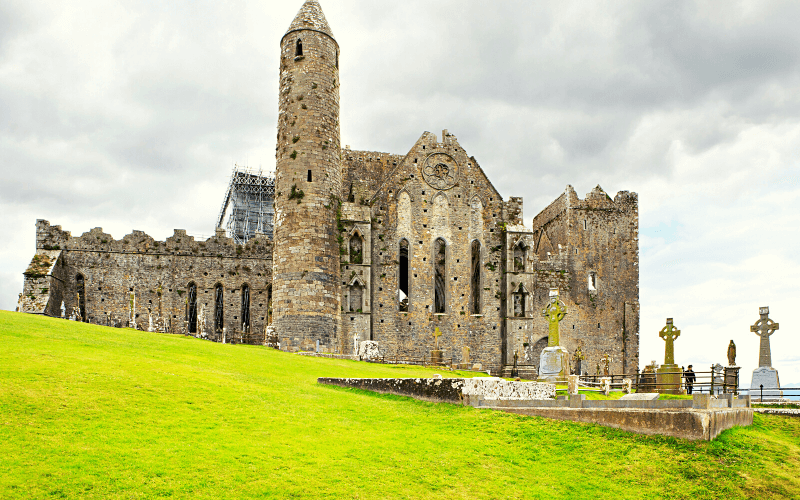
The Rock of Cashel is a legendary site in Ireland, associated with St. Patrick and his conversion of the Irish people to Christianity. As the seat of the Kings of Munster, the site holds immense historical significance and showcases a unique collection of medieval buildings.
Key features of the Rock of Cashel include:
- Cormac’s Chapel: An exquisite example of Romanesque architecture, Cormac’s Chapel dates back to the 12th century and is renowned for its intricate stone carvings and frescoes.
- Round Tower: Standing at 90 feet tall, the Round Tower is an iconic part of the Rock of Cashel’s skyline and offers panoramic views of the surrounding countryside.
- St. Patrick’s Cross: A replica of the original 12th-century High Cross, St. Patrick’s Cross is believed to mark the spot where St. Patrick himself baptized King Aengus in the 5th century.
Link to Rock of Cashel website.
These notable Irish castles serve as both testaments to the country’s rich history and popular attractions for visitors from around the world.
Conclusion
The evolution of Irish castles, from the earliest fortifications such as ringforts and crannogs to the grand stone castles of the 13th century, and later to the more modest tower houses and fortified manor houses, reflects the rich tapestry of Ireland’s history. These castles played a crucial role in shaping the political, social, and architectural landscape of the country, providing insight into the various periods of Irish history, from the Viking settlements to the arrival of the Normans and beyond.
Preservation of these historic castles has been vital in ensuring their continued relevance in modern Ireland. Many castles, such as Dublin Castle, Kilkenny Castle, and Bunratty Castle, have been restored and transformed into popular tourist attractions, providing an immersive experience that connects visitors to Ireland’s past. The preservation efforts have also been essential in safeguarding the heritage and cultural legacy of these ancient structures, allowing future generations to appreciate and learn from them.
Irish castles are more than just architectural marvels; they are windows into the soul of Ireland’s past, telling the stories of the people, events, and influences that have shaped the nation. By studying and preserving these castles, we can continue to unravel the complex history of Ireland, ensuring that the tales of its rich heritage live on for generations to come.

